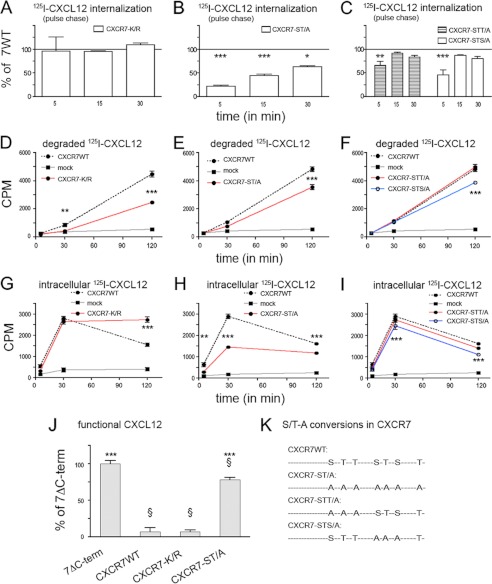FIGURE 7.
Influence of C-terminal lysine and serine/threonine residues on CXCR7-mediated endocytosis and degradation of CXCL12. HEK293 cells were transiently transfected with empty vector (mock), CXCR7-WT, CXCR7-K/R, a CXCR7-ST/A mutant lacking all C-terminal serine and threonine residues, CXCR7-STT/A with S335A, T338A, and T341A conversions, and CXCR7-STS/A with S350A, T352A, and S355A conversions. A–C, receptor-mediated internalization of 125I-CXCL12. Cells were loaded with radioligand at 4 °C (pulse), PBS washed, and lysed immediately (starting value) or incubated for the indicated time intervals at 37 °C and lysed after an acidic wash (chase). Percent internalization was calculated by dividing counts of internalized 125I-CXCL12 in the acid-washed groups by the starting value. Internalization data were then normalized to CXCR7-WT-transfected sister cultures (100% line). A, CXCR7-K/R and CXCR7-WT mediate similar 125I-CXCL12 internalization. B and C, as compared with CXCR7-WT, 125I-CXCL12 internalization via CXCR7-ST/A is reduced at 5, 15, and 30 min and 125I-CXCL12 internalization via CXCR7-STT/A and CXCR7-STS/A is reduced at 5 min after pulse labeling. D–F, release of degraded 125I-CXCL12. Cells were incubated with 125I-CXCL12 as indicated. Supernatants were subjected to TCA precipitation before degraded 125I-CXCL12 was counted. As compared with CXCR7-WT, CXCR7-K/R, CXCR7-ST/A, and CXCR7-STS/A cause slower accumulation of extracellular 125I-CXCL12 degradation products. G and H, intracellular accumulation of 125I-CXCL12. Cells were incubated with 125I-CXCL12 as indicated, subjected to acidic wash, and lysed. As compared with CXCR7-WT, CXCR7-K/R transfectants accumulate more, whereas CXCR7-ST/A and CXCR7-STS/A transfectants accumulate less 125I-CXCL12. A–I, two-way ANOVA. Asterisks indicate significant differences between wild type and mutant receptors. Data represent mean ± S.E. calculated from 2 independent experiments with 4 repeats each. J, influence of receptor-mediated scavenger activity on functional CXCL12. CXCL12 (20 nm) was incubated overnight with HEK293 cells transfected with the indicated receptors. Supernatants were used to stimulate transwell migration of Jurkat T cells. Migratory response with supernatants from CXCR7ΔC-term was used for normalization. * and §, Student's t tests versus CXCR7-WT (*) or versus CXCR7ΔC-term (§). Data are 3 independent experiments with 2–6 repeats each. K, schematic representation of the CXCR7 C terminus showing C-terminal serine (S) and threonine (T) residues and ST/A conversions in the mutant receptors.

